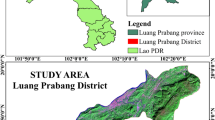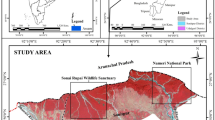Abstract
We mapped the forest cover of Khadimnagar National Park (KNP) of Sylhet Forest Division and estimated forest change over a period of 22 years (1988–2010) using Landsat TM images and other GIS data. Supervised classification and Normalized Difference Vegetation Index (NDVI) image classification approaches were applied to the images to produce three cover classes, viz. dense forest, medium dense forest, and bare land. The change map was produced by differencing classified imageries of 1988 and 2010 as before image and after image, respectively, in ERDAS IMAGINE. Error matrix and kappa statistics were used to assess the accuracy of the produced maps. Overall map accuracies resulting from supervised classification of 1988 and 2010 imageries were 84.6% (Kappa 0.75) and 87.5% (Kappa 0.80), respectively. Forest cover statistics resulting from supervised classification showed that dense forest and bare land declined from 526 ha (67%) to 417 ha (59%) and 105 ha (13%) to 8 ha (1%), respectively, whereas medium dense forest increased from 155 ha (20%) to 317 ha (40%). Forest cover change statistics derived from NDVI classification showed that dense forest declined from 525 ha (67%) to 421 ha (54%) while medium dense forest increased from 253 ha (32%) to 356 ha (45%). Both supervised and NDVI classification approaches showed similar trends of forest change, i.e. decrease of dense forest and increase of medium dense forest, which indicates dense forest has been converted to medium dense forest. Area of bare land was unchanged. Illicit felling, encroachment, and settlement near forests caused the dense forest decline while short and long rotation plantations raised in various years caused the increase in area of medium dense forest. Protective measures should be undertaken to check further degradation of forest at KNP.
Similar content being viewed by others
References
Achard F, Eva HD, Stibig HJ, Mayaux P, Gallego J, Richards T, Malingreau J. 2002. Determination of deforestation rates of the world’s humid tropical forests. Science, 297(5583): 999–1002.
Asian Development Bank (ADB). 2002. Country Assistance Plans — Bangladesh: III. Sector Strategies. Available at: http://www.abd.org. [Last access on 23 November 2010].
Bangladesh Bureau of Statistics (BBS). 2005. Compendium of environment statistics of Bangladesh. Ministry of Planning, Government of the People’s Republic of Bangladesh, pp 226–227.
Bentum EK. 2009. Detection of land use and land cover change in the Accra Metropolitan Area (Ghana) from 1990 to 2000. M.sc. thesis, Royal institute of technology, Sweden.
Browder JO, Wynne RH, Pedlowski MA. 2005. Agroforestry diffusion and secondary forest regeneration in the Brazilian Amazone: further findings from the Rondonia Agroforestry Pilot Project (1992–2002). Agroforestry System, 65: 99–111.
Congalton RG, Green K. 1999. Assessing the Accuracy of Remotely Sensed Data: Principles and Practices, Map Sciences Series. Florida: Lewis Publishers, Boca Raton, p.137.
Deng JS, Wang K, Deng YH. 2008. A PCA base land use change detection and analysis using multitemporal and multispetial satellite data. Remote Sensing of Environment, 30: 1054–1060.
Dewan AM, Yamaguchi Y. 2008. Using remote sensing and GIS to detect and monitor land use and land cover change in Dhaka Metropolitan of Bangladesh during 1990–2005. Environmental Monitoring and Assessment, 25(9): 23–24.
Eva H, Carboni S, Achard F, Stach N, Durieux L, Faure JF, Mollicon D. 2009. Monitoring forest areas from continental to terrestrial levels using a sample of medium spatial resolution satellite imagery. ISPRS Journal of Photogrammetry and Remote Sensing, 10(1016): 1–7.
FAO (Food and Agriculture Organization of the United Nations). 2006. Global Forest Resources Assessment 2005. Rome, Italy. ISBN 92-5-105481-9
Franklin J, Woodcock CE, Warbington R. 2000. Multi attribute vegetation maps of Forest Service lands in California support resource management decisions. Photogrammetric Engineering and Remote Sensing, 6: 1209–1217
Fraser RH, Abuelgasim A, Latifovic R. 2005. A method for detecting large scale forest cover change using coarse spatial resolution imagery. Remote Sensing of Environment, 95: 414–427.
Halim MA, Chowdhury MSH, Nahar MN, Sohel MSI, Jahangir NM, Koike M. 2008. Evaluation of land use pattern change in West Bhanugach Reserved Forest, Bangladesh, using remote sensing and GIS technique. Journal of Forestry Research, 19(3): 193–198.
Hossain A. 2005. Remote sensing in Bangladesh. In: Bangladesh Review, January–March, 2005. Department of Films and Publications, Ministry of Information, Government of the People’s Republic of Bangladesh, pp. 56–62
Iftekhar MS, Hoque AKF, Islam MR. 2003. Root causes of forest encroachment: A critical analysis for Bangladesh. Integrated Coastal Zone Management, Ministry of Water Resource, pp.1–11.
Infrared Processing and Analysis Center (IPAC). 2009. Site level field appraisal for integrated protected area co-management Khadimnagar National Park. Available at: http://www.nisorgo.org. [Last access on 6 December 2010]
Islam J, Ahmed AN, Hossain MA, Rashid MM, Atauzzaman M. 2006. Deforestation study of Dinajpur Sal Forest using GIS and remote sensing techniques. J Subtrop Agric Res Dev, 4(1): 47–54.
Islam J, Quadir DA. 1988. Modhupur forest map based on digital classification of Landsat TM data. Dhaka, Bangladesh: SPARRSO (Space Research and Remote Sensing Organization)
Jensen JR. 1996. Introductory digital image processing. New Jersay: Prentice Hall.
Karia JP, Porwal MC, Roy PS, Sandhya G. 2001. Forest change detection in Kalarani Round, Vadodara, Gujarat-A remote sensing and GIS approach. Journal of the Indian Society of Remote Sensing, 29(3): 129–135.
Li XY, Wang ZM, Song KS, Zhang B, Liu DW, Gue ZX. 2007. Assessment for salinized wasteland expansion and land use change using GIS and remote sensing in the West Part of Northeast China. Environmental Monitoring and Assessment, 131: 421–437.
Lillesand TM, Kiefer RW. 2000. Remote Sensing and Image Interpretation. John Wiley and Sons, New York.
Mukul SA, Uddin MB, Uddin MS, Khan MASA, Marzan B. 2008. Protected area of Bangladesh: Current status and efficacy for biodiversity conservation. Pakistan Academy of Science, 45(2): 59–68.
Nishorgo. 2008. Protected Area Co-management Where Poverty and Forest Intersect: Lesson From Nishorgo in Bangladesh. In: DeCosse PJ, Thompson PM, Ahmad IQ, Sharma RA, Mazumder AH (eds). Nishorgo Network, a joint venture protected area co-management programme of USAID and Bangladesh Forest Department.
Panigrahy RK, Kale MP, Dutta U, Mishra A. 2010. Forest cover change detection of Western Ghats of Maharashtra using satellite remote sensing based visual interpretation technique. Current Science, 98(5): 657–664.
Phong LT. 2004. Analysis of forest cover dynamics and their driving forces in Bach Ma National Park and its buffer zone using remote sensing and GIS. M.sc Thesis, Faculty of Geo-information Science and Earth Observation (ITC), University of Twente, the Netherlands.
Quadir DA, Rahman A, Haque F, Ahmed IU, Runkel M. 1998. Monitoring of forest cover in Chittagong forest division of Bangladesh using remote sensing and GIS techniques. Journal of Remote Sensing and Environment, 2: 1–18.
Roy PS, Giriraj A. 2008. Land use and land cover analysis in Indian Context. Journal of Applied Sciences, 8(8): 1346–1353.
Singh A. 1989. Digital change detection technique using remotely sensed data. International Journal of Remote Sensing, 10(6): 989–1003.
Uddin K, Gurung DR. 2005. Land cover change in Bangladesh- a knowledge based classification approach. (Available at: http://geoportal.icimod.org. [Last access on 19 November, 2010]
United States Agency for International Development (USAID). 2006. Landuse/Land cover maps of six protected areas of nishorgo support project (NSP). Available at: http://www.nisorgo.org. [Last accessed on 13 December, 2010]
Vina A, Echavarria FA, Rundquist DC. 2004. Satellite change detection analysis of deforestration rates and patterns along the Colombia-Ecuador Border. Royal Sewdish Academic of Sciences, 33(3): 117–127.
Author information
Authors and Affiliations
Corresponding author
Additional information
Corresponding editor: Hu Yanbo
Rights and permissions
About this article
Cite this article
Redowan, M., Akter, S. & Islam, N. Analysis of forest cover change at Khadimnagar National Park, Sylhet, Bangladesh, using Landsat TM and GIS data. Journal of Forestry Research 25, 393–400 (2014). https://doi.org/10.1007/s11676-014-0467-9
Received:
Accepted:
Published:
Issue Date:
DOI: https://doi.org/10.1007/s11676-014-0467-9




